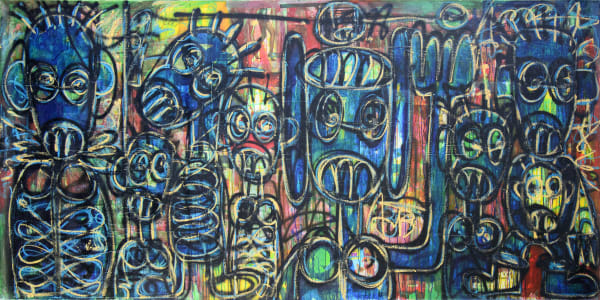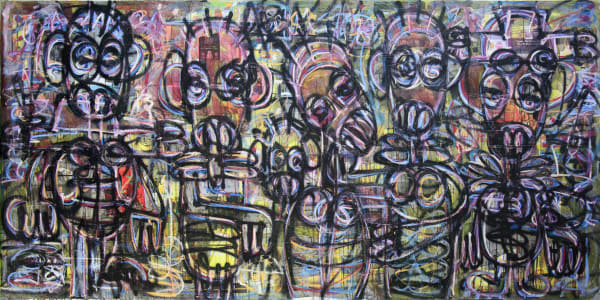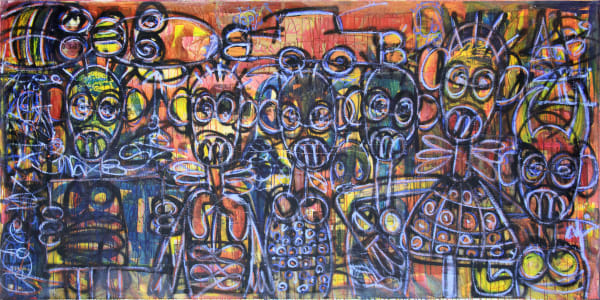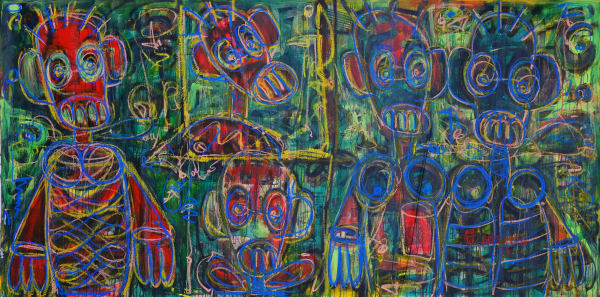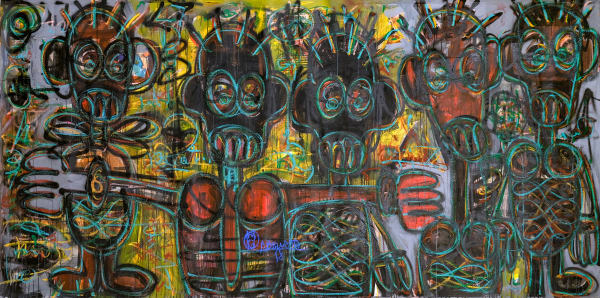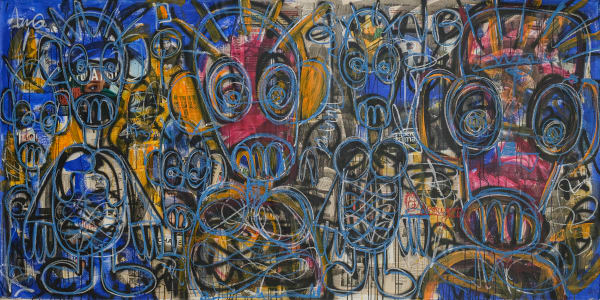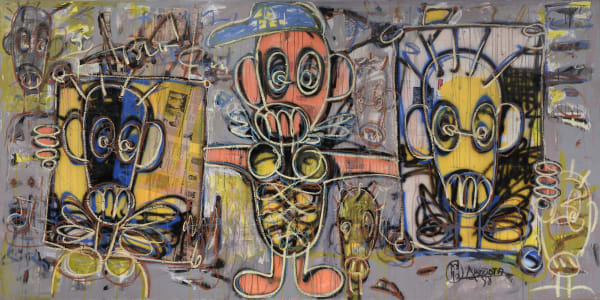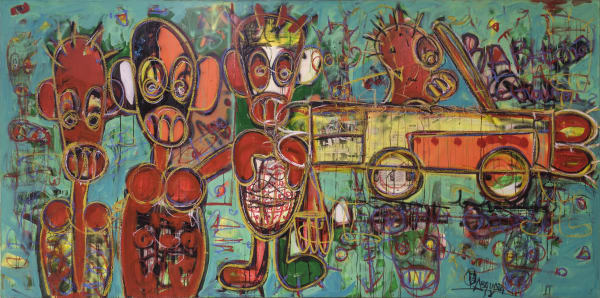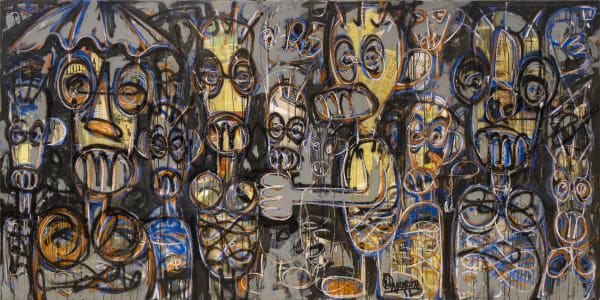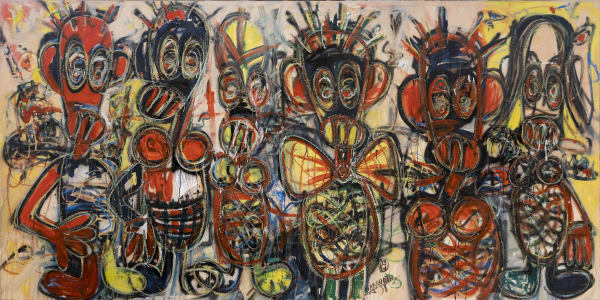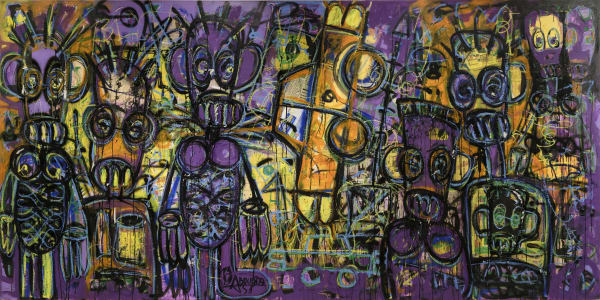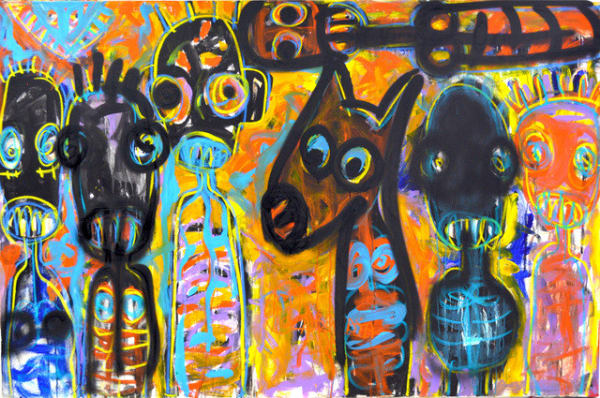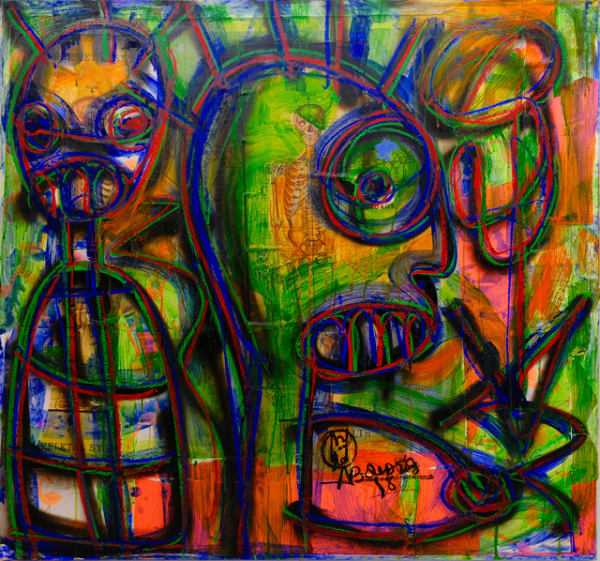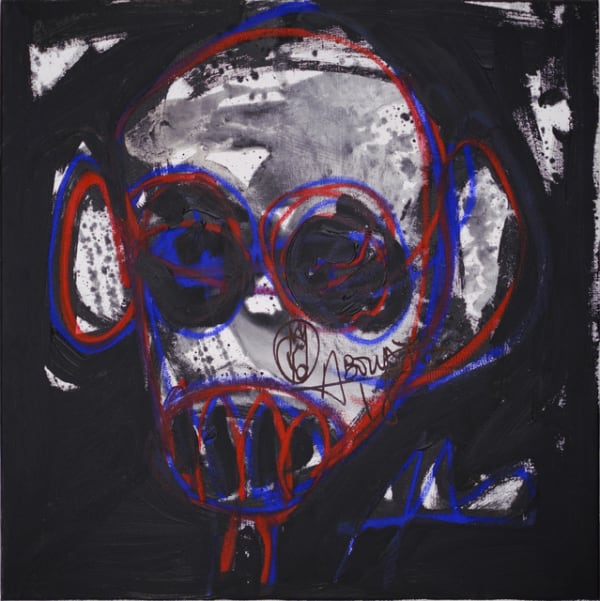Aboudia: Nouchi Graffiti: 259 W 19th St
Ethan Cohen Gallery is pleased to present Aboudia: Nouchi Graffiti, its sixth solo exhibition of Aboudia’s works, which will take place at Ethan Cohen Annex on 259 West 19th Street, from December 9 through January 8. Nouchi Graffiti pairs new large paintings with select masterful works from 2016.
Abdoulaye Diarrassouba a.k.a. Aboudia (b. 1983, Ivory Coast) draws inspiration from the graffiti, tribal art , and the street culture of his hometown Abidjan, Ivory Coast. Aboudia brilliantly portrays the street culture of urban Africa with complex paintings featuring street children’s faces intermixed ghosts of tribal masks as part of his symbolic language. He draws on images that defined his early life growing up in poverty on African streets – street art, traditional tribal art, violence from the civil war, the poverty of the street children of Abidjan, the social inequalities of his hometown – and he reimagines and condenses them into complex and vivid paintings.
Aboudia’s trademark “Nouchi” style is drawn from the street culture of children in his home city of Abidjan, Ivory Coast. The word “Nouchi” refers to their street patois which, combined with the ubiquitous graffiti around Abidjan, inspires Aboudia’s work – a form of dreamscape in response to poverty and deprivation. To Aboudia, Nouchi represents his life, his upbringing, his journey, and the plight of all impoverished street children. Rendered in oil sticks, acrylics, collage, and spray paint, his works are noted for stark lines of color that grow electrically.
Aboudia’s story as an artist is a story of hope and success. Aboudia began his artistic career on the streets of Abidjan as a graffiti painter. When he was a teenager, upon sharing his decision to become an artist with his family he was thrown out and told that he was on his own. Upon graduating from the Institute Des Arts, Abidjan, the local galleries and art scene in the region was not receptive to the work he was creating. It was only after international galleries and collectors began noticing his work that he gained acclaim. What pushed him into the international spotlight were the paintings he made during the armed conflict of the 2010 Ivory Coast presidential election. Coverage of the conflict often included Aboudia’s paintings of the war, with skulls, AK-47s, rocket launchers, guns, and dark landscapes of death, destruction, and despair. After the conflict ended, Aboudia returned to his original subjects of representation, which include reflecting on the cultural history and social realities of the children of the street. His works express poverty and distress yet his choice of color provides a glimmer of hope from the eyes of the street children, of which he once was. This past year Aboudia has had breakthrough auctions at all the major auction houses which has brought even more attention to his art practice and his story. His market has grown over ten-fold from last year, and his work is included in numerous significant international collections.
 Aboudia, Nouchi Graffiti: Les Coquins et Leur Chien, 2021
Aboudia, Nouchi Graffiti: Les Coquins et Leur Chien, 2021 Aboudia, Nouchi Graffiti: Les Enfants d'Abidjan, 2021
Aboudia, Nouchi Graffiti: Les Enfants d'Abidjan, 2021 Aboudia, Les Coquins d'Abidjan en Couleur, 2021
Aboudia, Les Coquins d'Abidjan en Couleur, 2021 Aboudia, Nouchi Graffiti: Les Enfant Des Visages Bleu et Rouge, 2021
Aboudia, Nouchi Graffiti: Les Enfant Des Visages Bleu et Rouge, 2021 Aboudia, Nouchi Graffiti Vitalité, 2021
Aboudia, Nouchi Graffiti Vitalité, 2021 Aboudia, Nouchi Graffiti Power, 2021
Aboudia, Nouchi Graffiti Power, 2021 Aboudia, Nouchi Graffiti Electrique, 2021
Aboudia, Nouchi Graffiti Electrique, 2021 Aboudia, Aboudia Aboudia Afrique, 2021
Aboudia, Aboudia Aboudia Afrique, 2021 Aboudia, Nouchi Graffiti Le Gourou, 2021
Aboudia, Nouchi Graffiti Le Gourou, 2021 Aboudia, Nouchi Frères et Soeurs d'Abidjan, 2021
Aboudia, Nouchi Frères et Soeurs d'Abidjan, 2021 Aboudia, Les Dappers d'Abidjan, 2021
Aboudia, Les Dappers d'Abidjan, 2021 Aboudia, Nouchi Graffiti Fireworks et l'Orange Voiture, 2021
Aboudia, Nouchi Graffiti Fireworks et l'Orange Voiture, 2021 Aboudia, Protest Color Tagged, 2016
Aboudia, Protest Color Tagged, 2016 Aboudia, Nouchi Graffiti en Verte, 2021
Aboudia, Nouchi Graffiti en Verte, 2021 Aboudia, Nouchi Graffiti Series, 2020
Aboudia, Nouchi Graffiti Series, 2020




